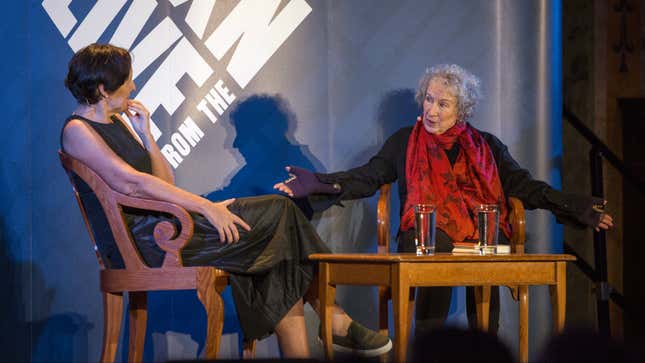“What was the author trying to say?” This common question in English classes is often posed by a professor who then reveals various ideas hidden within a novel as if they were a clear, neatly ordered message, waiting to be unpacked. From this perspective, writing is full of both signs and disguises, all of which hints at the author’s true meaning but also cloak it in unnecessary complexity.
This way of thinking misses the point entirely, argues Margaret Atwood, Canadian novelist and recipient of numerous literary prizes. The meaning is in the words themselves, not in some argument hidden within the writing. Atwood recently published Hag-Seed, a contemporary retelling of Shakespeare’s The Tempest. At a New York Public Library event alongside actress Fiona Shaw, an English teacher in the audience asked if Atwood wrote with the intention of being analyzed for hidden themes and meaning.
“It’s all the fault of how we were taught in high school, in which the teacher had the benefit of the finished book and would draw a diagram on the blackboard. It gives you the idea that the writer always had that diagram and was just translating it into this unnecessary amount of language,” replied Atwood. “The inference is: What was the poet trying to say? Poor lamb, he couldn’t just blurt it out. He had to fancy it all up. He really had a speaking problem.”

The meaning of any literary work is not one that can be reduced into a simple theory, Atwood argues.
“I’m not a Platonist,” she said. “I don’t think the meaning exists somewhere up here and then is translated down into all this verbiage. I believe the meaning emerges out of the language and that the reader is the musician of the text.”
Everyone will respond to a literary text slightly differently, based on their own experiences and the passages that are personally significant. There’s a range of appropriate reactions, says Atwood. So King Lear, for example, should never be read as a comedy.
“But within that range, the number of interpretations and shades of meaning are almost infinite, because each person doing it brings him or herself to it,” she adds. “Reading is very interactive.”
This then raises questions about what, exactly, the author intended to evoke as they wrote their novel. If writers don’t begin with the blackboard diagram of an argument, then how does so much meaning and nuance find its way into their work? Atwood addressed this idea earlier in the talk, when Fiona Shaw mentioned how Shakespeare reverses the rhythm of his iambic pentameter for the three witches in Macbeth. In their speech, the word “Macbeth” is the only one that’s slightly too big for the line, and so stands out, seeming to rise above the others.
“It’s a bit like music, nobody needs to consciously know this but it’s very useful if the actor knows it,” said Shaw. “The real question is, did the writer know it?”
In a crucial way, replied Atwood, Shakespeare certainly knew. “He might not have known it schematically,” she said, but he still realized the impact of each word. It’s an instinct, added Atwood, “Sort of like, ‘These curtains don’t go with that sofa.’ ”




